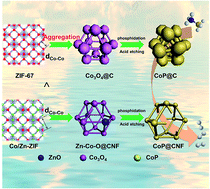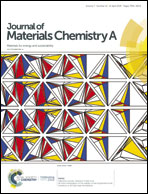Tailoring three-dimensional porous cobalt phosphides templated from bimetallic metal–organic frameworks as precious metal-free catalysts towards the dehydrogenation of ammonia-borane†
Abstract
The development of an effective and safe hydrogen evolution catalytic system depends on the advent of a well-established hydrogen-economy paradigm in the future. Catalytic hydrogen generation from promising hydrogen storage materials, such as ammonia-borane (AB), has drawn extensive attention in recent years. However, the wide use of noble metal catalysts in the catalytic hydrogen generation from AB is one of the formidable challenges in the practical application of this strategy on a large scale. Herein, using a bimetallic metal–organic framework (MOF) template strategy, we successfully engineered three-dimensional (3D) porous cobalt phosphide carbon-based nanoframeworks (CoP@CNFs) as precious metal-free and efficient catalysts. Zn present in the MOF precursor plays the dual crucial role of separating the Co ions and maintaining the framework during pyrolysis. As a result, the porous CoP@CNF exhibits large specific surface area, a hierarchical porous structure, well-exposed active sites and hydrophilic channels, yielding the extraordinary initial total turnover frequency (TOF) of 165.5 mol(H2) mol(Co)−1 min−1 for hydrogen generation from AB.



 Please wait while we load your content...
Please wait while we load your content...